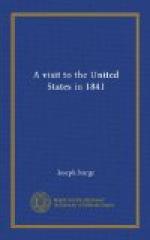Joshua Leavitt, proprietor and editor of the New York Emancipator, a large weekly abolition newspaper, and secretary of the American and Foreign Anti-slavery Society, is another remarkable man, clear and sound in judgment, and efficient in action. He is justly regarded by American abolitionists as one of their ablest supporters.
La Roy Sunderland, member of the Executive Committee, and editor of “Zion’s Watchman,” a Methodist, religious, and anti-slavery newspaper, with his slight figure, dark intellectual face, and earnest manner, is pointed out to the anti-slavery visitor from the Old World as the most prominent advocate of emancipation among the Wesleyans. His boldness and faithfulness have combined against him the leading influences of his denomination, but notwithstanding he has been several times tried by ecclesiastical councils, they have always failed to substantiate the charges against him, and his vindication has been complete.
Theodore S. Wright, member of the committee, is a colored presbyterian preacher in this city—an amiable man, much and deservedly respected.
All the above mentioned individuals, who have from an early period been among the most zealous and laborious members of the anti-slavery committee, found themselves placed by the events of last year in the position of seceders from the American Anti-Slavery Society, though their opinions had undergone no change. They now belong to the American and Foreign Anti-Slavery Society, or as it is technically called the “new organization,” a distinction which will be afterwards explained.




